Nature Conservation 2021 — 10. 6. 2021 — Nature and Landscape Management — Print article in pdf
European Ground Squirrel – An Umbrella Species for Biodiversity Rich Farmland

In the Czech Republic, a sharp decline in agricultural landscape biological diversity has recently become very urgent. The topic even now and then jumps from scientific journals and enters into mass media, thus confirming its weight and severity. The fact demonstrates the seriousness of this topic, which also starts to be noticed by part of the general public. Almost always negative cases are mentioned, but positive examples of a biodiversity rich agricultural land-scape appear rarely. The authors would therefore like to introduce the readers to the mosaics of vineyards, orchards, fields and steppes on the outskirts of the town of Velké Pavlovice (South Moravia). These may not only provide inspiration to those restoring varied agriculture landscapes, but mainly pose a great challenge to preserve them.
Visit to the ground squirrel in the land of wine and apricots
In the Velké Pavlovice´s surroundings, a survey based on the local population of the critically endangered European ground squirrel (Spermophilus citellus), also known as the European souslik, was initiated. The animal, which we can regard an excellent umbrella species in the conservation of agricultural landscapes, is interesting in many ways. After World War II, the ground squirrel had still been a rather common species and was persecuted by farmers for the considerable damage causing to a wide range of cultivated crops. With the loss of mosaic agricultural landscapes, it rapidly disappeared and today it is rather considered to be an animal of airports, campsites and golf courses. When taking a view of the landscape with the original ground squirrel population on the western and northern outskirts of Velké Pavlovice, it can well be noticed that the substitute habitats do not have much in common with its original habitat.
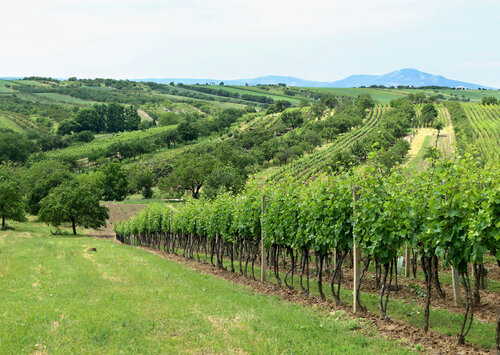
Picturesque landscape in sight of the Pavlov Hills, connecting variously managed
farmland and remnants of steppe habitats. © Kateřina Poledníková
It is a landscape where the tenure of most of the land has remained preserved and which has only marginally been affected by land consolidation. The hilly landscape is divided into narrow strips where ploughed and grassy vineyards and orchards alternate with fields of vegetables, cereals, alfalfa and other crops, fallow land, abandoned orchards and vineyards, thickets and scrub, but also remnants of steppe grasslands. All this is intersected by a network of cart tracks, most of which are not paved and have the original clay-grassy character. In the 500 ha large study area, the average tract area is 0.47 hectare, in the central part even 0.28 hectare, which corresponds to the situation in the Czech Republic around the year 1948. In comparison, the average land block size in the Czech Republic today is 5.9 ha.
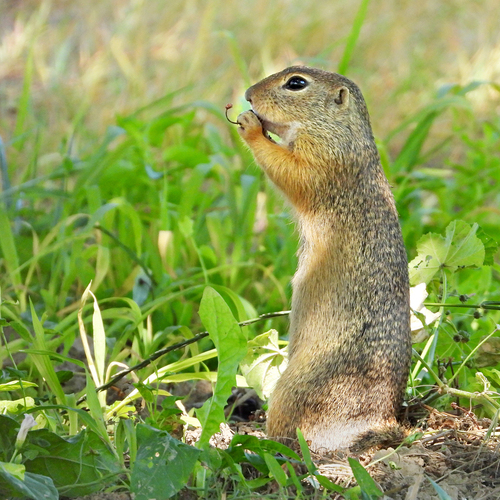
The main colony of the European ground squirrel (Spermophilus citellus) at Velké Pavlovice
is situated at sites where the landscape mosaic is the finest and the cultivated crops
the most diverse. © Hannah Findlay
Almost endlessly diverse and mosaic landscape
The high biodiversity of the area is based on several pillars. Botanically most important are undoubtedly remnants of steppe and fringe vegetation, but also the occurrence of segetal species (e.g. the Annual yellow woundwort Stachys annua, Monkswort Nonea pulla, the European stickseed Lappula squarrosa). It is exactly weed species that are generally rare in the common agricultural landscape today. This vegetation is partly restricted by the use of herbicides also in the study area,, but in the rich mosaic of variously farmed plots with a significant percentage of fallow land, there are always sites where weed species get a chance to flower and set seed. However, their occurrence varies with time and space. The dynamics is almost absent from the common agricultural landscapes. Large units with very uniform farming methods and crop composition simply make it impossible.
The diversity in cultures and the land use, together with various preserved remnants of natural habitats, manifests itself much more pronounced in the diversity of animals than plants. For xylophagous insects, regularly scattered old and dying fruit trees are present. When the appropriate habitat disappears, another suitable substrate is almost always available within flying distance. Out of the many recorded endangered species e.g. the conspicuous Cherry borer or Colorful cherry jewel beetle (Anthaxia candens) should be mentioned. In the hollows of old fruit trees, the development of the Flower chafer (Protaetia speciosissima) larvae takes place, and we can sometimes also encounter here our largest beetle, the European stag beetle (Lucanus cervus), whose larvae live on the roots of dying old trees. Dry old wood and often also wooden poles in vineyards host the colourful longhorn beetle, the Grape wood borer (Chlorophorus varius), which can be found on flowers of the Field eryngo (Eryngium campestre) and yarrow (Achillea spp.) species in the middle of summer. The endangered ironclad beetle Colobicus hirtus has been recorded under the bark of dead walnut trees. The small Wine jewel beetle (Agrilus derasofasciatus) lives in dry grapevine twigs.
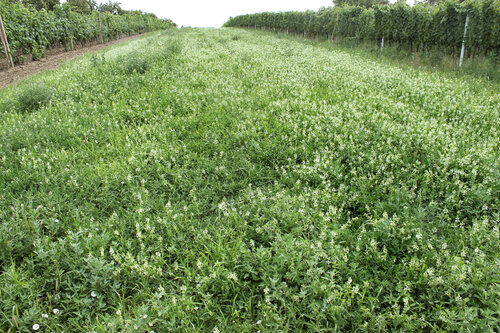
View of fallow land with the strongly endangered weed Annual yellow woundwort
(Stachys annua), nowadays an absolutely unique situation. Mostly small populations
of just a few plants are found in the margins of arable fields or vineyards. © Libor Ekrt.
Frequent crop rotation in combination with the vegetation of abandoned orchards, baulks and steppes provides the landscape with a high proportion of transient (ecotone) structures which are lacking from the present landscape. Also these host a range of important species. An example recorded at Velké Pavlovice is the rare crab spider Tmarus stellio, which is in the Czech Republic found only rarely in southern Moravia. It lives in margins of thickets and on lower branches of solitary trees, where it actively looks for prey. Other very rare fauna species include the small longhorn beetle Glaphyra kiesenwetteri, whose development takes place in drying rose shrubs in xerothermic habitats.
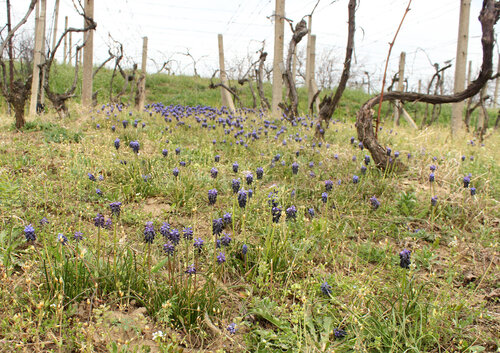
The strongly endangered grape-hyacinth Muscari neglectum is locally common
in the surroundings of Velké Pavlovice. It is a plant which tolerates shallow
ploughing well and therefore accompanies hoed and ploughed vineyards
and orchards. © Libor Ekrt
The local mosaic landscape is absolutely essential for species preferring various types of fallow land, disturbed plots and margins of arable fields and paths. These species are found in protected areas only sparsely. Their occurrence is concentrated in open agricultural landscapes where these organisms are substantial part of biodiversity there. They include many endangered and rare species for which the almost endlessly rich mosaic landscape in the surroundings of Velké Pavlovice is a real paradise. A good example are weevils, beetles which mostly prefer various open places with sparse vegetation, path verges, fallow land and other disturbed places in open landscapes. Many of them are endangered species and their occurrence demonstrates the high biological value of the area. A common species in the study area is the weevil Pseudocleonus cinereus, which occurs in the Czech Republic only locally just in southern Moravia. It lives on different plant species of the Asteraceae family in sparse non-forest vegetation. Another endangered thermophilous weevil species Lixus angustus, is associated with the Hawkweed oxtongue (Picris hieracioides). Lixus vilis lives on the Redstem stork's bill (Erodium cicutarium), whereas the larvae of another weevil, Rhabdorrhynchus seriegranosus, develop in the roots of the Viper´s bugloss or Blueweed (Echium vulgare). Also the fauna of epigeous predators, particularly ground beetles, is very rich there. Significant steppe species living in disturbed places with sparse vegetation include e.g. ground beetles Callistus lunatus, Poecilus punctulatus and Pterostichus longicollis. The species Dyschiriodes bonellii and Harpalus zabroides are the rarest ground beetles of exposed loess terraces. Important thermophilous spider species, which regularly farmed vineyards on loess terraces suit well can also be found there. Examples are the conspicuous metal-coloured running spider Micaria dives, a small spider by the name of Phrurolithus pullatus, and the contrastingly coloured false crab spider Rhysodromus histrio, which was recorded here for the first time in the Czech Republic in 2002.
Natural habitats should be cherished
The isolated natural habitat remnants, mostly represented by various types of steppe vegetation and scrub in the study area, are undoubtedly essential from a biodiversity perspective. Their size and species saturation cannot compete with the South Moravia extensive steppe sites, but the patchwork of these habitats closely connected with a mosaic agricultural landscape is exceptional.
South-facing slopes of dry baulks among vineyards or in the upper parts of abandoned farmland on slopes host remnants of steppe pasture communities with the Volga fescue (Festuca valesiaca), Hairy feather grass (Stipa capillata) and the Field wormwood (Artemisia campestris). Steppe vegetation with the significant European feather grass (Stipa pennata) is represented to a lesser extent. Locally, especially on more disturbed land, vegetation with the heavily dominating Transylvanian melic grass (Melica transsilvanica) is found. North- to northeast-facing slopes on the other hand host broad-leaved Pannonian dry grassland vegetation with rich populations of the Prostrate Canary Clover (Dorycnium pentaphyllum agg.), yellowhead Inula ensifolia and many other species. Exceptionally attractive plants include the rare Military (Orchis militaris) and Fragrant (Gymnadenia conopsea) orchids. The Leafless hawksbeard (Crepis praemorsa) and the parasitic broomrape, the Wormwood broomrape (Phelipanche arenaria), both growing there, belong to the most endangered species of the Czech Republic´s flora. Concerning shrubby vegetation, low steppe scrub in which the European dwarf cherry (Prunus fruticosa) dominates should be mentioned.
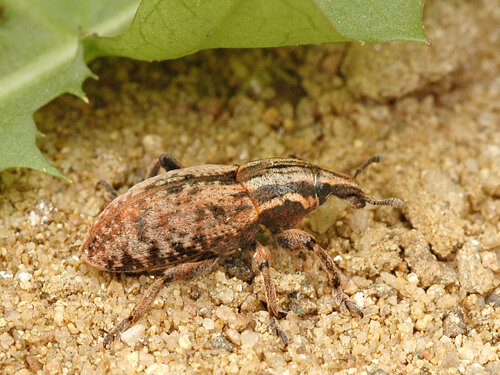
The weevil Pseudocleonus cinereus is a rare species of disturbed sites with sparse vegetation.
It occurs rather commonly on cart tracks and in vineyard margins. © Václav Křivan
Looking at the invertebrate fauna diversity, the local steppe vegetation fragments reflect the large steppe sites in the region. Particularly phytophagous beetle families, such as weevils and leaf beetles, are richly represented. Important species of relict steppes include e.g. the jewel beetles Cylindromorphus filum and Trachys problematicus, and the leaf beetles Cheilotoma musciformis, Coptocephala chalybaea, Pachnephorus pilosus and Pachybrachis fimbriolatus.

View of an enclave of valuable steppe vegetation in a broad baulk surrounded
by vineyards. In several places, low steppe scrub vegetation with the
European dwarf cherry (Prunus fruticosa) is richly developed. © Libor Ekrt
As for spiders, steppe remnants host the most significant, critically endangered species like the slender crab spider Tibellus macellus, which is in the Czech Republic traditionally known only from the nearby Pouzdřany Steppe, and in the Czech Republic critically endangered money spider Metopobactrus ascitus, individuals of which have only been observed at a few steppe sites in the very south of Moravia.
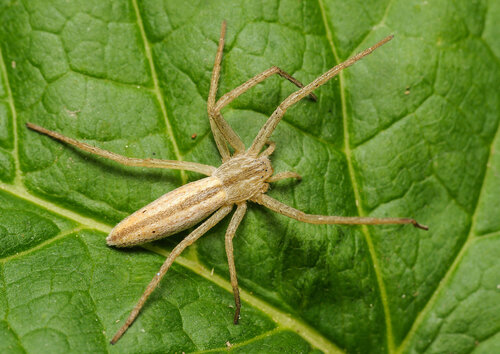
Slender crab spider Tibellus macellus, preferring steppe grasslands and forest
steppes, is a critically endangered European species whose occurrence is
concentrated in the Pannonian region and Eastern Europe. © Radek Šich
How much longer will there be anything to admire?
With regards to the abovementioned facts it must however be stressed that this favourable situation definitely need not last forever. On the contrary, as in most natural habitats, a considerable degree of degradation is evident there. In some cases, valuable communities are on the brink of extinction. The most serious problem is the absence of at least occasional management of steppe habitats, which undergo succession and become slowly encroached with shrubs, trees and/or expansive grass species. Land is grazed by horses in only one case, but neither the desired gradual reduction of shrubs and trees is achieved there. Besides native trees and shrubs (e.g. the Common dogwood Cornus sanguinea, Rosa spp., Blackthorn Prunus spinosa, European wild privet Ligustrum vulgare, Sessile Oak Quercus petraea, Silver Birch Betula pendula, European ash Fraxinus excelsior), some places are strongly invaded by geographically non-native species (the Black locust Robinia pseudoacacia, Chinese wolfberry Lycium barbatum, Desert false indigo Amorpha fruticosa, the Box elder Acer negundo, etc.). Without systematic restoration and at least occasional management, the remnants of preserved natural habitats degrade, some may disappear completely, and the area loses its uniqueness. Moreover, gradual restoration of at least a minor part of the currently strongly degraded steppe vegetation is important.
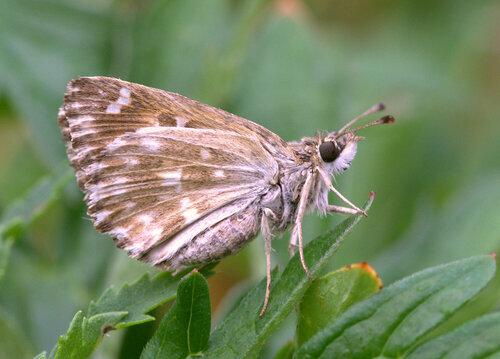
The Mallow skipper (Carcharodus alceae) can most often be encountered
at diverse steppe sites with disturbed patches, on fallow land and in path margins.
© Václav Křivan
Negative changes are also taking place in farming cultures. Most visible are the abandonment of old orchards and vineyards, and encroachment of these cultures by shrubs, trees and expansive grass species. However, farming is also significantly intensified in many places. Small vineyards and orchards are consolidated into larger blocks. Formerly mosaic areas are becoming monotonous maize fields or uniform vineyards without scattered solitary fruit trees. Some small fields with a variety of vegetables and root crops disappear. The regular use of herbicides has a very negative impact on the weed vegetation diversity.
Ground squirrel as an umbrella species
European ground squirrels occur across the whole study area, but in various densities. The main ground squirrel colony is situated at site where the land mosaic is the finest and the cultivated crops are the most diverse. Every ground squirrel has a part of a vineyard, fruit trees, a small vegetable field, a path verge, i.e. various food sources, in its territory. In early spring, freshly sprouting grass blades, dandelion leaves and roots are the basic nutrition. Over time, various grasses and herbs flower and their seeds and fruits ripen. In June the ground squirrels find fallen cherries and in July apricots, in between they feed on various crops from fields, vegetables and fodder plants. Also animal food, consisting of invertebrates and occasionally also small vertebrates, is an important component of the ground squirrel’s diet. Just like amount and diversity of available food influence the ground squirrel population, these rodents also influence other animal species. Ground squirrels used to be an important component in the diet of predators like the Saker (Falco cherrug) and the Steppe polecat (Mustela eversmanii), but today these species are critically endangered just as the ground squirrel itself is. In their holes, ground squirrels host a specific fauna, which is also present at this site, e.g. the coprophagous dung beetle Onthophagus vitulus and O. semicornis. The dead bodies of ground squirrels, hares and other vertebrates also host important necrophagous steppe species such as Nicrophorus germanicus, the largest burying or carrion beetle occurring in the Czech Republic and the hide beetles Trox cadaverinus and T. eversmannii.
Conclusion
The present situation of farmland biodiversity is very unfavourable in the Czech Republic. Besides a dramatic decline in many species of birds, invertebrates and formerly common segetal vegetation, the fact is very well documented by the occurrence of the European ground squirrel. Apart from current ‘Noah’s Arks’ like airports and campsites, ground squirrels only occur at a few original sites in southern Moravia, e.g. at Velké Pavlovice, Hrušovany u Brna, Čejč and Hovorany, and Újezd u Brna. For all of them, a rich mosaic of small fields, vineyards and orchards, but also high biodiversity of plant and animal species in comparison to the surrounding agricultural landscape is a common feature.
Despite the claims of some farmers that agriculture can only be performed on large tracts, there have still been varied agricultural landscapes with a high biodiversity in our country, which is interesting for part of the local population even from the perspective of livelihood. The combination of diversified agricultural use and presence of valuable natural habitats makes the surroundings of Velké Pavlovice a very significant site in southern Moravia. The area would therefore deserve targeted support, management and gradual restoration to be implemented in close cooperation with the State Nature Conservancy authorities and local communities.
The article was supported by project 304021D154 under the INTERREG V-A SK-CZ programme. It is also published with support of the Ministry of the Environment of the Czech Republic. The views and opinions expressed in this article are those of the authors and do not necessarily reflect the official policy or position of the Ministry of the Environment of the Czech Republic

